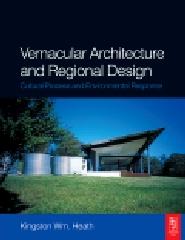A series of international case studies demonstrates the place of vernacular architecture in the design process for a wide selection of contemporary architects' work.
Offers a clear analysis of the vernacular building tradition, placing architecture in its social context.
Introduces a new, socially and environmentally inspired approach to sustainable design.
Description
A governing principle of sustainable architecture is that buildings need to reflect upon and respond to the environment they are placed in. Through a series of international case studies, Vernacular Architecture and Regional Design re-examines vernacular architectural theory and looks at what gives buildings a sense of place.
The book equips the professional architect with the tools to realise socially responsible principles as part of the design process. The case studies of contemporary architects' work provide real examples of how the study of vernacular architecture can contribute directly to practice in sustainable design. It considers architecture and design as integrated social processes, not just technical or aesthetic exercises, thus showing how local building traditions can become part of a wider architectural and social fabric.
Vernacular Architecture and Regional Design will appeal to professionals around the world in the fields of architecture, architectural heritage and urban design.

(0 Comentarios)